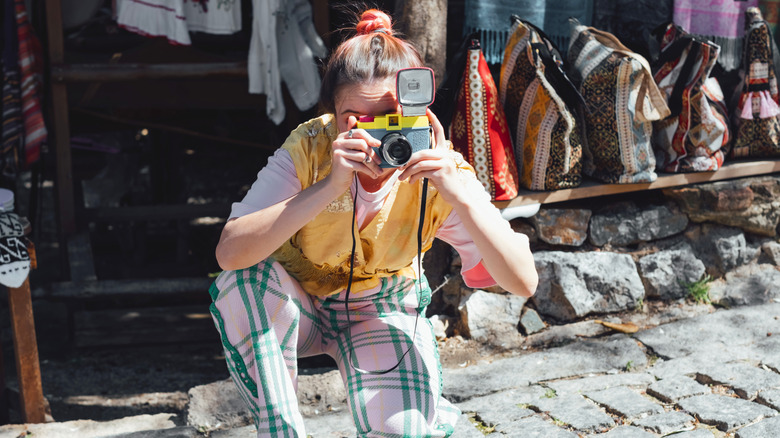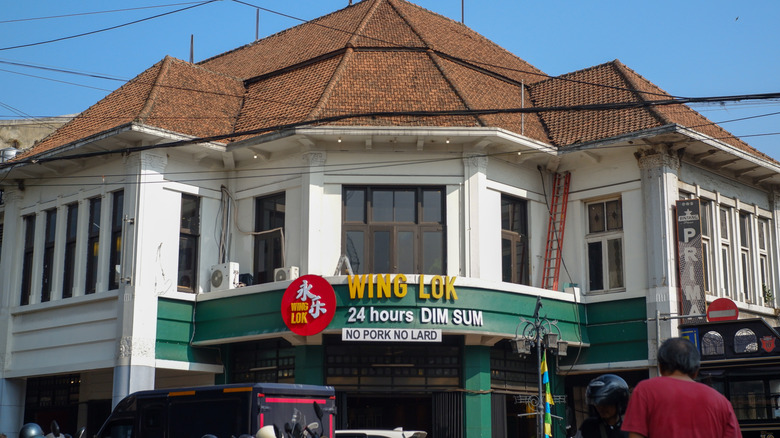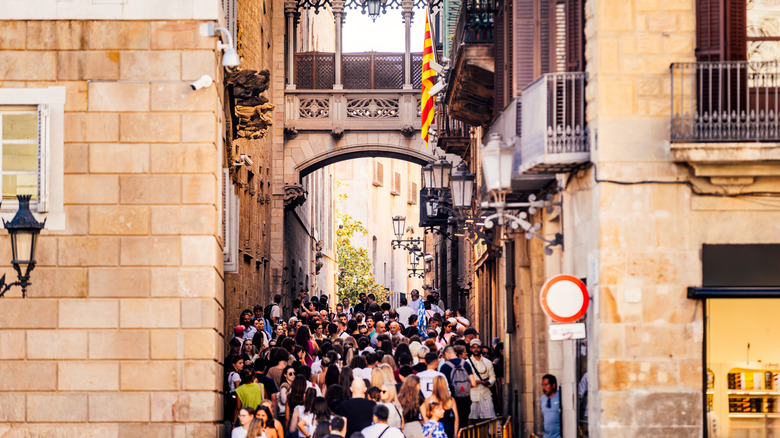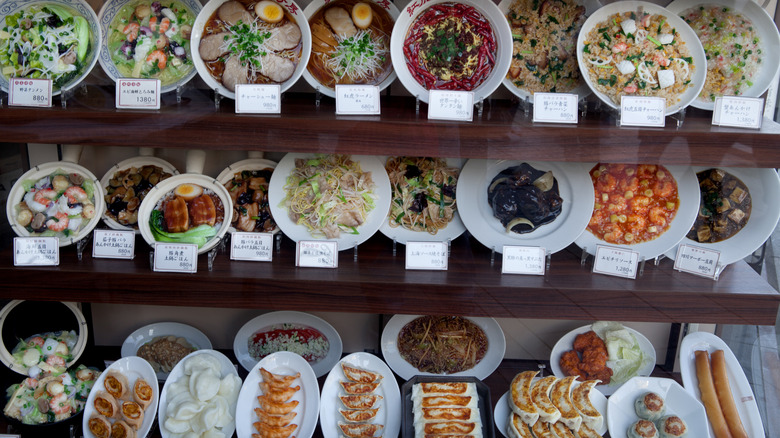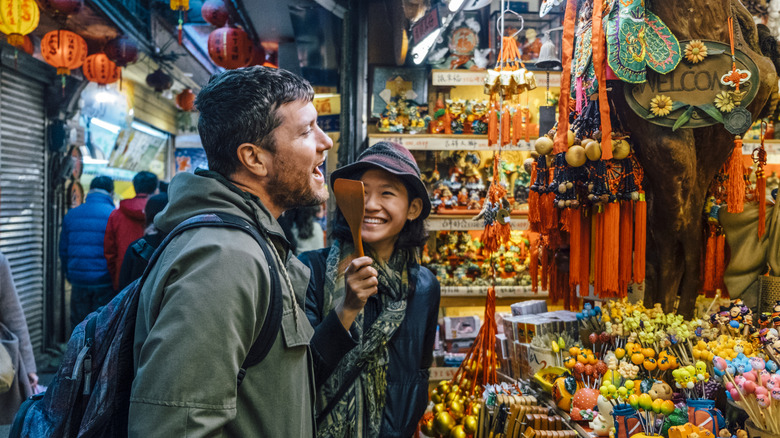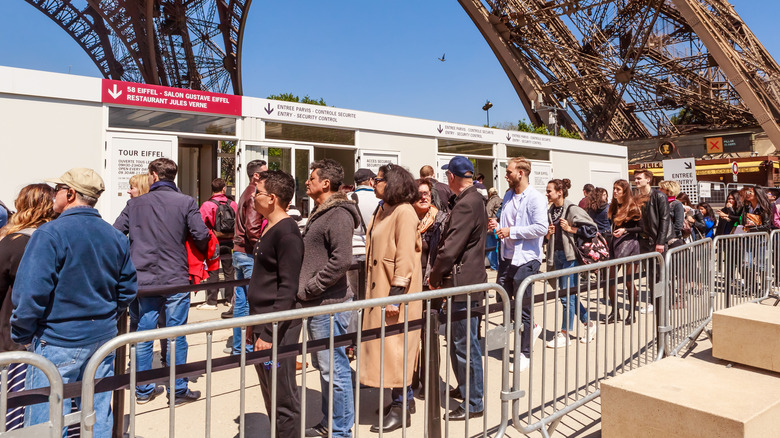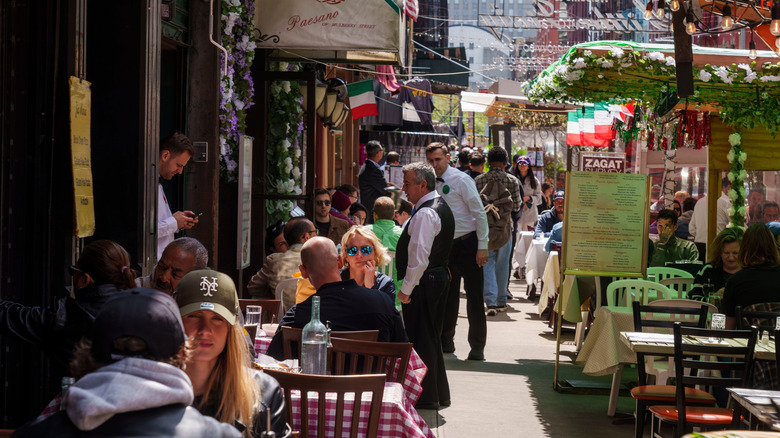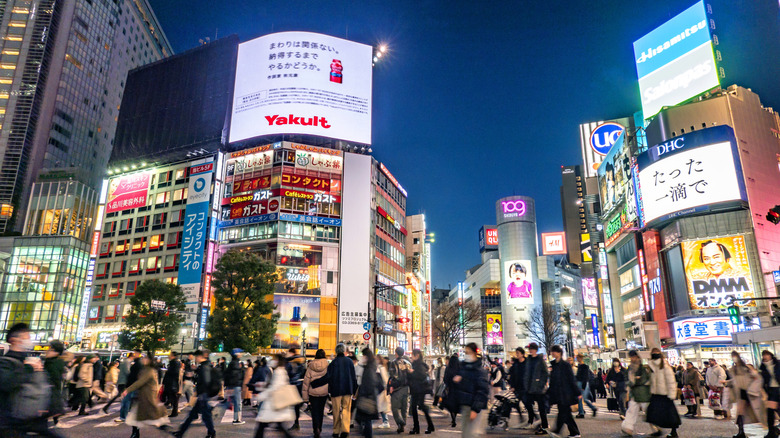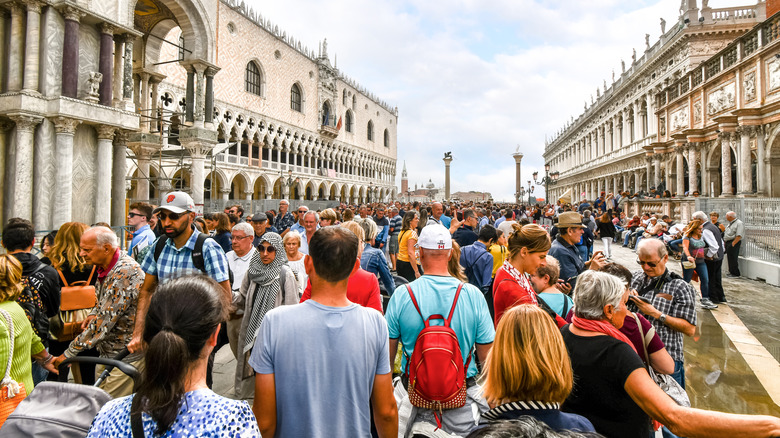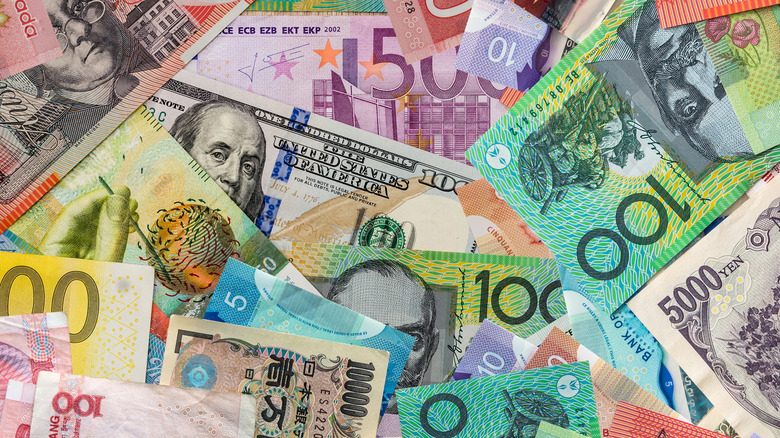12 Telltale Signs A Tourist Spot Won't Be Worth The Hype
When planning a vacation, there are some destinations you shouldn't miss. We're referring to those iconic sites that have carved a name for themselves around the world. These places elicit awe and wonder from travelers near and far, whether you believe the praise is justified. Think of the Taj Mahal in India (a place that requires some planning before a visit), the Pyramids of Giza in Egypt, Iguazu Falls on the border of Argentina and Brazil, and Uluru in Australia. In America, many notable spots — both carved by nature or sculpted by humanity — deserve our admiration.
Each comes with an outsize reputation, like the geological marvel of the Grand Canyon, the Art Deco lines of Miami Beach, the buzz and freneticism of New York City's Times Square, home to the world's greatest wax museum. But sometimes these tourist spots disappoint, and sadly never quite live up to the expectation they have gradually, irresistibly generated. That's when you might reach for the words "tourist trap." For instance, Niagara Falls is full of tourist traps that you should skip. While it's hard to foretell whether these destinations are worth the hype, some telltale signs will help you determine if the visit might be deflating. Here are some pointers to consider before you make the leap and head to your next tourist hotspot.
Restaurants that open all day
Our general eating schedule can be broken down into specific meals: breakfast, lunch, and dinner. Many don't religiously follow this regimen of three set meals daily. Some might cut one or more out or prefer to graze constantly throughout the day. However, the three dining windows are established enough to be a format for a good proportion of the world's population.
Restaurants recognize this pattern and, in general, will open around these meal times. Some might serve all-day meals, and others might only open for lunch, but a good eatery will usually provide food at a time that jibes with the typical eating schedule. So, if a restaurant opens for longer — for the entire day, for instance — it might be a sign that it's really looking for mass tourism business, trying to scoop up itinerant travelers in search of a bite to eat at odd hours. A poster on Reddit echoes these thoughts in r/solotravel, "Opening hours: genuine Italian restaurants that cater for locals will open for dinner no earlier than 7, while those catering to tourists will open all day."
The establishment is full of tourists
One of the joys of travel is to experience life in a different place. If you are lucky, your journey can allow you to feel almost like a local, even if fleetingly. This is one of the most thrilling aspects of travel. But you can only do that if you embed yourself into the local culture and experiences. That might mean walking around areas off the beaten path or shopping in neighborhood stores instead of tourist-frequented emporiums.
What you should avoid, at all costs, is the following scenario — you sit down in a café, restaurant, or bar or walk into a shop, and virtually every patron is a tourist. If this happens, then you should try to go elsewhere. While we aren't claiming that establishments that cater mostly to tourists are all bad, they typically aren't the best option. And they often don't work as tirelessly as local, neighborhood businesses. That is because tourist traps rely on frequent turnover to make money, not repeat business derived from offering a commendable product.
There is a gift shop
Nothing quite screams a "tourist trap," like a destination that has a gift shop. That's not to say every place that has a gift shop is a tourist trap that's not worth checking out. Some of the most interesting, unique items for sale can be found in museum gift shops; however, if the store seems unnecessary or just a money-spinning enterprise, give it a miss. Especially bad are the kinds of gift shops that sell items unrelated to the theme or purpose of the site you are visiting. You know exactly the kind of setup we are discussing.
It could be a tropical nut plantation that sells snow globes or an aquarium where the biggest seller is a stuffed toy of a fuzzy giraffe. And even if the gift shop sells thematically appropriate items, there is a high probability that they will be overpriced. Remember that no rule states you have to buy items in a gift shop, and if you find that the store dominates the attraction, give the place a miss entirely.
The restaurant has fake food displays
When sitting in a restaurant overseas and perusing the menu, a certain thrill forms from seeing the names and descriptions of dishes. Some might sound familiar, maybe you've had them back home, and others might be completely new. Scanning the words — possibly written in the local language — of dishes popular at the destination is another facet of the journey that reminds you that you have traveled far and are on vacation. That, at least, is how it should play out in an authentic, local restaurant that hosts regulars who sit at the exact table every week at the same time.
If, however, you approach a restaurant that's been blowing up all over social media or is the darling of guidebooks and blogs, and you see rubbery displays of food in the window, then consider eating elsewhere. If you can point to the dish you want instead of finding it on a menu, then the restaurant is a tourist magnet. What other explanation exists for fake food displays when a written menu is a commonly accepted method of showcasing the dishes a restaurant makes for its diners?
The location is full of street vendors
Popular tourism sites pull large crowds for a reason. It could be an incredible, haunting architecture, like the Basílica de la Sagrada Familia in Barcelona, an unfinished church designed by Antoni Gaudí. Or perhaps the delicate, delectable flavors offered by gelato shops in Florence. Or maybe the chance to enjoy a sumptuous meal with views of rolling vineyards in South Africa's Cape Winelands, the top tourist-friendly wine region in the country. Whatever the reason, these places offer something special and world-class.
But when that fame is hijacked by vendors looking to make a quick buck, it calls into question whether the site is worth visiting. When hordes of vendors hawking T-shirts of that tourist spot or a photographer appears promising a once-of-a-lifetime portrait of you in front of the attraction, you should quickly realize that commercialism has sullied the spectacle. Incessant exhortations from vendors urging you to buy a fridge magnet, keychain, commemorative plaque, or T-shirt will rapidly turn the spot into a circus.
Lines are excessively long
Just because a tourist spot has elevated itself to a place of high regard, a destination that you somehow can't miss, doesn't mean you have to see it. That's especially true if visiting it requires waiting in snaking lines that never seem to get any shorter. Sure, some places have those long queues because they are truly unique, and the time spent in them will be worth it once you set your eyes on the attraction. But others aren't that special, and you probably will have just as good an experience at another café, bagel joint, retail shop, museum, or entertainment facility.
Think of it as a simple equation. Does standing in a line for four hours, for example, to see the tomb of a former leader for 30 seconds, seem like time well spent? Or does waiting for an hour to gain entry to a cool café guarantee that its food, drinks, and ambiance are so much better than a similar, quieter joint just around the corner? Hint: the answer is probably no. Sometimes, long lines don't signify that something is better or more desirable than a competitor; they just mean that the place in question is in vogue for one reason or another.
Restaurants that have a host outside trying to pull in customers
A restaurant that serves good food and has a steady stream of repeat clientele doesn't need to go to the ends of the Earth to maintain consistent business. The food, after all, speaks for itself, which is why diners make a point to return to enjoy it. But a restaurant that has an employee or a host out on the street, beckoning customers to come in, even when it's not mealtime, clearly shows that it is trying to entice unsuspecting tourists. It also indicates that the dishes served might be a underwhelming; otherwise, why would they be so desperate for business?
Any traveler who has been to Little Italy, on the edge of Chinatown in New York City, has probably witnessed this firsthand. As a contributor to the r/solotravel subreddit explains, "If the restaurant has an employee stationed outside whose job is to rope in more customers, it's almost certainly a tourist trap."
Additionally, if the restaurant claims to serve "authentic" cuisine — whatever that means — alarm bells should go off in your head. Even worse is a restaurant that has a laminated or multilingual menu and cooks various types of cuisine. How can it do real justice to different types of cuisine when most restaurants specialize in one?
The spot keeps appearing on social media feeds
It's one thing for a popular tourist spot to appear on social media feeds with dependable regularity. After all, who doesn't want to broadcast that they are at the Sydney Opera House or Dubai's Burj Khalifa, the tallest building in the world? However, a consistent flow of appearances is nothing compared to a deluge of them, which is increasingly frequent on platforms like Instagram or TikTok.
When a tourist spot figuratively blows up on these sites, its profile starts to rocket, and people suddenly swarm it. Many of these visitors are simply riding the wave of social media saturation, tailgating the trend, and checking out a place to see what all the fuss is about without actually gauging its merit. Once a tourist spot keeps reappearing on a social media site, with photos and descriptions embedded in each post, travelers might also feel like they already know the place.
When that place becomes widely publicized in this way, it can create an unreasonable expectation for tourists who visit. As a commenter on Reddit explains in r/travel, "... [since] it's so easy to see videos/vlogs/pictures of the things you're going to see, you develop far more expectations than you would before, [ruining a] lot of the surprises..." It's always better to visit a tourist site because you want to, not because it is the hottest thing around. Check out how to determine if you should use TikTok to plan a vacation.
A billboard or sign uses superlatives
In your travels, you have probably seen a store, restaurant, garden, or attraction that claims it is the "biggest" or "largest" of its type or offers something belonging to those categories. An example could be the world's biggest selection of sausages, or the largest variety of orchids on the planet. Or a restaurant that professes to serve the best of its cuisine in the city (think to yourself, how would it even prove that?).
While these might be enviable attributes and perhaps worth advertising, you need to question the methods of broadcasting this information. If the claims are plastered on large signs or billboards or heavily leaned into any marketing collateral, then perhaps the destination is more concerned about wowing visitors with quantity and salesmanship, not quality. That suggests that gimmicks are a big part of the appeal of the place, and that should be a turn-off to any potential visitor. Do us a favor, and don't fall for the hype.
Prices are high
One of the most frustrating experiences when you are on vacation — and even when you are not — is the feeling of being taken for a ride. Like buying a T-shirt at a stand close to a major attraction for $20, only to find the exact item being sold in a quiet alley away from the madding crowds for a fraction of the price. This is a clear red flag; a tourist spot isn't worth the hype if it sells something for markedly more than another establishment nearby.
Money is hard to come by and quick to go, so why would you want to quicken that process by overpaying at a tourist trap? Typical venues that charge too much are restaurants and cafés close to a popular square, major museum, or tourist attraction. Shops in those locations selling things like souvenirs will get a healthy share of their business from tourists, and since these visitors might be unaware of the going rate for an item, the stores can unscrupulously overcharge. Shop around, understand the price of things, and don't presume that if something costs more, it is of better quality.
You'll see huge tour groups
For the average independent traveler, tour groups are the kiss of death for a tourist site. See a tour group — the kind where a herd of visitors is led by someone holding a flag or umbrella, and suddenly you'll feel that the tourist site is not a bonafide attraction but rather a commodity that needs to be checked off a list. Tour groups often rush through a site and give it a perfunctory look before moving on to the next spectacle on their roster. They are, as Rick Steves might say, more tourists than travelers.
A place that welcomes tour groups forgoes that sense of intimacy, that unique connection it has with the visitor, which is one of the most joyous memories we can have when we travel. Tour groups can also feel very impersonal, as they feel detached from the site itself, and that mass of people wandering around almost aimlessly has an effect on the ambiance of a destination. The easiest way to tell if a tourist spot caters to this kind of crowd is if you notice signs or spaces in the parking lot for coaches.
The destination accepts payment in multiple currencies
While phone payments and bank cards for purchases are commonplace for travelers, cash is very much still widely used. Some vendors aren't set up to process bank payments, and others prefer not to deal with the bureaucracy and taxes entailed with using such an arrangement. Cash buyers also sometimes get better prices than those using a virtual payment method. But what if you pull out your wallet or purse and are about to hand over some softly worn bills, and you spot a sign at the store or attraction that states payment is accepted in different currencies? What do you do then?
The first question you need to ask is why. The answer is obvious—because it caters to tourists from all over the world and believes that any money, whatever currency, is better than none. It should quickly become evident that the site is a huge tourist trap that likely favors commerce over a classy experience. Put the money back in your purse and find somewhere that feels more authentic and less crass.
